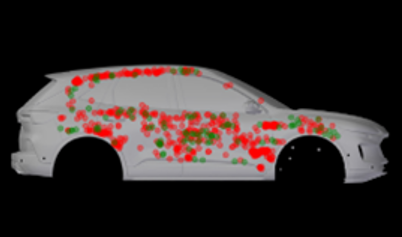Let’s suppose an automotive factory uses heat maps to inspect the paint on cars. Heat maps can show areas of the vehicle where the paint is not applied correctly or where there are imperfections. If the maps show that certain areas of the hood and doors consistently have paint issues, engineers can investigate and adjust the painting equipment or process to solve these problems.
8 Reasons Why Heat Maps Are Important in This Context:
1. Defect Identification
Heat maps allow for the visualization of defects or irregularities in automotive components. This helps in identifying problematic areas quickly and accurately.
2. Trend Analysis
Heat maps can show trends in defect occurrence over time or across different production batches. This facilitates pattern recognition and informed decision-making regarding changes in the production process.
3. Real-Time Monitoring
In automated production lines, heat maps can be integrated with real-time monitoring systems to detect quality issues immediately, enabling rapid intervention and minimizing waste.
4. Process Optimization
By visualizing the frequency and location of defects, engineers can adjust manufacturing processes to reduce the incidence of errors. This may involve changes to machines, tools, or operating procedures.
5. Effective Communication
Heat maps provide an intuitive and easy-to-understand way of presenting quality data, facilitating communication between different teams, from plant operators to executives.
6. Inspection Method Validation
They can be used to validate the effectiveness of existing inspection methods. If patterns of defects are detected that current methods are not capturing, it indicates a need to improve inspection techniques.
7. Problem Prevention
By analyzing historical heat maps, it is possible to anticipate future issues and conduct preventive maintenance or adjustments before defects impact production.
8. Customization and Adaptation
Heat maps allow for quality control to be tailored to different models and versions of automotive products, ensuring a high standard of quality across the entire product range.
Heat maps are powerful tools in the detection and control of quality in the automotive industry. They facilitate rapid identification of issues, process optimization, and continuous improvement, significantly contributing to the production of high-quality vehicles and customer satisfaction.
At Eines Vision Systems, we generate 3D heat maps to extract the maximum amount of information from a single inspection in the shortest possible time. Contact us to learn more about these tools.
Additionally, we will soon discuss new advancements in our paint tunnel that will mark a significant breakthrough in paint defect inspection. Stay tuned…





